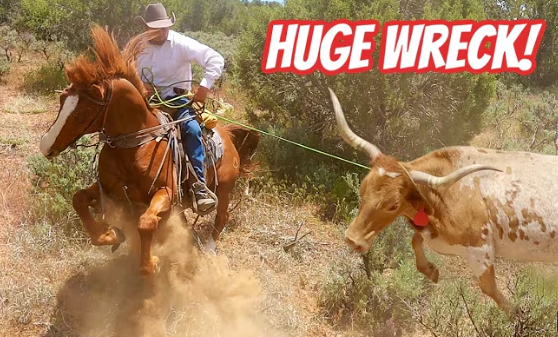A Routine Day Turns Dangerous
What began as a typical cattle drive in the open scrublands of the Southwest quickly turned into a heart-pounding disaster. Experienced ranch hands, seasoned horses, and well-trained cattle were supposed to make for a smooth morning. But nature — and cattle — have minds of their own. In this case, a particularly unruly longhorn decided it had no intention of cooperating.
The photo above captures the precise moment when control was lost. A cowboy on horseback is yanking his reins while a powerful horse rears back, kicking up clouds of dust. At the other end of the rope? A massive, horned steer thrashing violently as it tries to break free. The look on both animals’ faces says it all — chaos had taken the reins.
How It All Started
Early that morning, the cattle drive began like any other. Cowboys saddled up at dawn, checked their tack, and rounded up the herd from a holding pasture. The plan was to move a group of 50 head of cattle five miles across the ranch to a new grazing area. For seasoned cowboys, this was routine — almost relaxing.
But about an hour into the drive, trouble emerged from within the herd. One particularly large longhorn began showing signs of agitation. It was snorting, tossing its head, and trying to break away from the group. Rather than following the trail like the others, it suddenly charged toward the brush, threatening to scatter the herd.
The Wreck Begins
A quick decision had to be made. One cowboy, known for his roping skills, broke off to intercept the rogue steer. With precision and speed, he swung his lasso and landed it cleanly over the animal’s horns. But the steer wasn’t going down without a fight. As soon as it felt the rope tighten, it jerked violently, pulling the cowboy’s horse sideways.
Caught off guard, the horse lost its footing and began to buck, attempting to stabilize itself on the loose terrain. Dust exploded from the ground as hooves pounded into dry soil. The cowboy, still gripping the rope, tried to maintain control, but the steer pulled with shocking strength. The line snapped tight between man and beast, turning the scene into a dangerous tug-of-war.
Danger for Horse and Rider
In situations like this, both horse and rider are at risk. A horse can easily be thrown off balance by a strong pull, especially when on uneven terrain. In the photo, you can see the moment the horse begins to rear — nostrils flared, eyes wide. The cowboy, meanwhile, is leaning back, trying to regain control of the horse while holding tension on the rope.
This is the kind of moment that ranchers refer to as a “wreck” — when things spiral out of control and you just hope to make it out without injury. The term is often used to describe close calls, and this one definitely qualifies.
Teamwork Saves the Day
Fortunately, help was nearby. Two more cowboys quickly rode in, working in unison to calm the longhorn and help bring it back under control. One cut off its escape route, while the other roped its hind legs — a technique known as “heading and heeling.” Once the steer was secured, they were able to get it lying down, where it could be calmed and checked for injuries.
The first cowboy dismounted, his horse trembling with adrenaline but uninjured. A tense few minutes passed as the dust settled and everyone took a breath.
Lessons Learned from the Trail
This incident serves as a stark reminder that even the most routine ranching tasks can become dangerous in a split second. Horses are incredibly powerful animals, but they are also sensitive to fear and stress. When a rider is tethered to an unpredictable steer, the risk to both the cowboy and the horse multiplies.
It also highlights the importance of teamwork. Had this cowboy been alone, the situation could have ended very differently — with broken bones or worse. But because the crew worked together swiftly and with clear communication, no one was seriously hurt, and the steer eventually calmed down.
Why These Stories Matter
Cattle drives are more than just ranch chores — they’re part of the heritage and daily life of many people living in the American West. Incidents like this reflect the unpredictable nature of working with animals, where instincts and quick thinking often matter more than training.
These stories offer a glimpse into a lifestyle that still thrives today, far from the modern urban hustle. They also serve as cautionary tales — not to discourage the work, but to underscore the need for respect, caution, and humility in the face of nature.
Final Thoughts
The phrase “cattle drive gone wrong” might sound dramatic, but for those who live this life, it’s a part of the reality they face. Every wreck is a lesson. Every steer that breaks away teaches cowboys something new about handling, patience, and resilience. And every successful recovery, like the one in this story, strengthens the bond between rider, horse, and team.
Out on the open range, it’s not just about muscle and grit — it’s about trust, timing, and teamwork.
